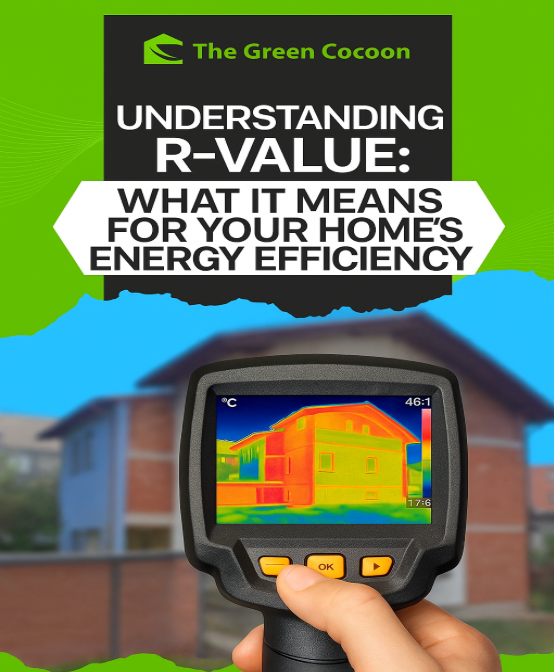Most homeowners will first hear the term "R-value" when it comes to insulation. It is a common measure adopted by manufacturers, retailers, and even some contractors to ascertain the performance of insulation. Although R-value is important, it will not help you save on your power bills.
The fact is, the energy efficiency of your home does not just rely on a number. The quality of installation, air sealing, and the form of insulation material you use have a significant influence on the extent to which your home can retain conditioned air.
At The Green Cocoon, we are here to help homeowners make wise choices regarding insulation. The following will break down why R-value is not the entire story and what you also need to look at to gain real energy savings.
What is R-Value?
R-value is a thermal resistance measure. The greater the R-value, the more effective the insulation is in contain the flow of heat. For example, a wall that has R-19 insulation will resist heat transmission compared to one with R-11 insulation.
When insulation has been poorly woven, compressed, or encircled by air leaks, the efficiency R-value may considerably diminish.
This implies that even a home that has high R-value insulation can lose energy unless the installation is airtight or the material does not work under your unique circumstances.
Why R-Value Alone Isn't Enough
1. R-Value is Compromised by Air Leakage
One of the largest energy loss causes in homes is air movement. Naturally, warm air ascends and escapes via attics and cold air sneaks in via cracks and gaps. Unless insulation is combined with appropriate air sealing, the highest R-value material will not help you to stop the rise of your energy bills.
2. Condensation and Moisture Problems
Dryness is equally significant to thermo resistance. Some forms of insulation, such as closed-cell spray foam insulation, are both a thermal barrier and a moisture barrier. Otherwise, insulation may not be as effective as time passes, causing you to be less comfortable and spend more money.
3. Material Matters More Than You Think
Insulation is not a one-size-fits-all. For example:
- Open-cell foam insulation is great for interior wall soundproofing as well as air sealing.
- Closed-cell spray foam insulation has higher R-values per inch and doubles up as a vapor barrier; thus, it is best suited to basements, crawl spaces, and roofs.
Selecting the appropriate material in the appropriate area is the key to significant savings.
4. Installation Quality Makes or Breaks Performance
The most insulated product may not work correctly if installed improperly. When they do not fit the bats properly, or there are gaps in and about the electrical boxes, or when there is an uneven application of spray foam, this lowers efficiency. This is why it is important to work with insulation contractors.
The Impact of Building Science on Saving Energy
Energy efficiency has to do with the home as a system. Walls, windows, roofs, HVAC systems, and insulation all interact. An improvement in R-value in itself will not help unless you deal with the interaction between these components.
For example:
- Even with an attic having R-38 fiberglass, the attic can still consume energy with air leakages are not sealed.
- A basement that is simply finished using fiberglass could experience condensation unless an airtight substance such as closed-cell foam is used.
- Framing or outlets with gaps in the walls can decrease the overall performance of high R-value insulation.
When you take the number out of the picture and look more at the system, you will get the true picture of what you can save.
Best Methods For Homeowners to Save Energy
Select the Material to use in specific spaces
- Open-cell foam insulation is good in walls and sound-sensitive places.
- Closed-cell spray foam insulation is the most appropriate where moisture resistance and the high R-value per inch are of concern.
- Fiberglass and cellulose may work in attics and walls when air-sealed correctly.
Collaborate with Reliable Home Insulation Companies
Select a company that considers your home as a whole and offers solutions that suit your needs and does not necessarily sell the product with the highest R-value.
Conclusion: Beyond R-Value to Real Energy Savings
Even though R-value is a significant parameter in insulation performance, it is not the only parameter that counts. Whether your home becomes energy efficient depends on air sealing, moisture control, the choice of material, and the quality of the installation.
To reduce your utility or energy costs and to enhance your year-round comfort, you cannot afford to be satisfied with insulation solutions that are limited to R-value.
Collaborate with The Green Cocoon, the reliable brand in insulation that is environmentally friendly and allows us to make your house more efficient.







